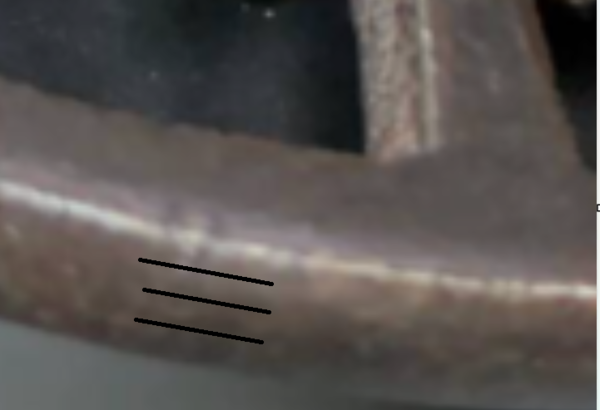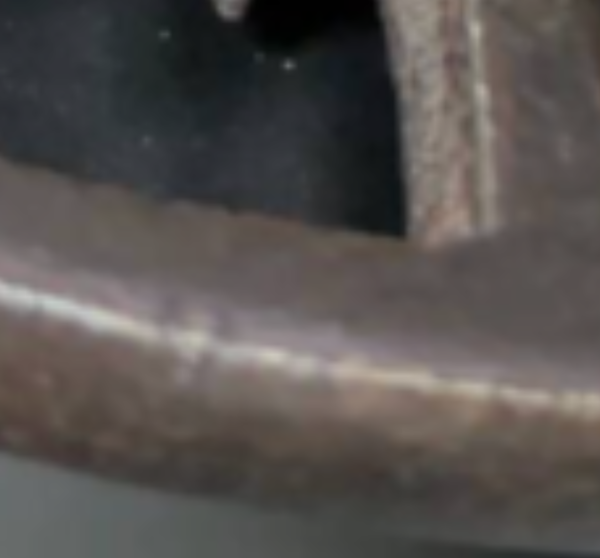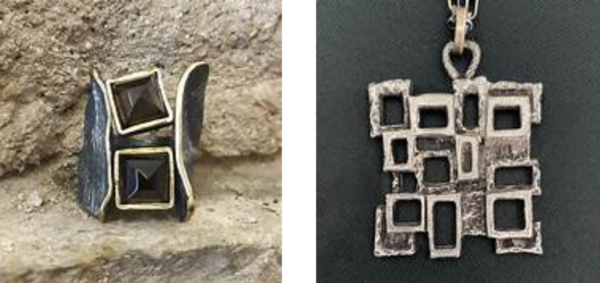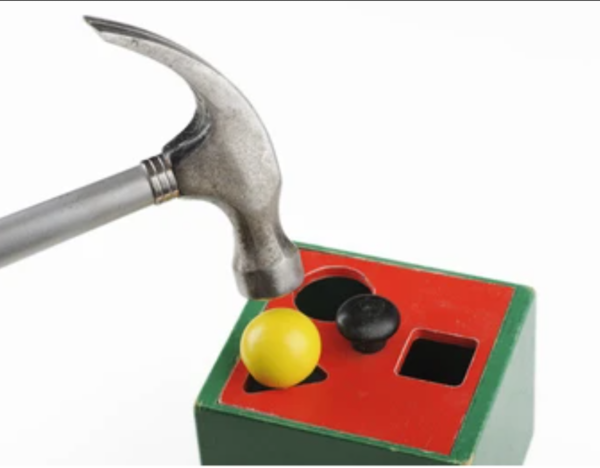-
Posts
721 -
Joined
-
Last visited
-
Days Won
13
Content Type
Profiles
Forums
Events
Store
Downloads
Gallery
Everything posted by GRC
-
Thanks Mauro! The compiled version is certainly going to be a valuable resource for everyone. It may also serve as a window into how certain types of mumei tsuba were being classified by Sato Kanzan (and by association, the NBTHK) during that time period. It could be a useful benchmark to see how similar tsuba are being papered today and note the shifts in attributions in recent times. Not to mention, seeing some great tsuba examples along the way
-
Nanban or Hizen... not Jakushi (although there's a similar look to the nunome, Jakushi never did this tsuba shape or did this type of design theme). It's probably a Chinese craftsman working in one of the ports in Japan (therefore should get a hybrid combined attribution of both Nanban and Hizen... which never happens in the papering world, because they are fixated on sticking to the narrow set of categories that were agreed upon in the past. Both categories of Nanban and Hizen are loosely defined at best and have lots of issues... so the exact attribution under those two labels is kind of arbitrary anyway. Either way, it's an unusual tsuba so congrats on your first purchase.
-
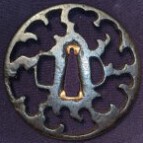
Can this tsuba have been made by fusing two iron plates?
GRC replied to Iaido dude's topic in Tosogu
Here’s a nice example of a ko-akasaka seppa-dai that shows the four layers on the outside edge of the sepa-dai. It even has a split along the middle layers like the tsuba that started this thread… but nowhere near the same level of separation. Regardless, the whole notion of a “three layered construction” needs to be tossed aside. i’m still leaning toward a few freeze thaw cycles affecting the “tokkei” one, but who knows. -

Can this tsuba have been made by fusing two iron plates?
GRC replied to Iaido dude's topic in Tosogu
Good to know Jean. I never would have imagined creeping rust to create such a huge gap between layers. That's pretty amazing actually. Oh and what is this tsuba forging seminar you mentioned? Are you presenting it virtually or in person or both? -
nice. I missed the gourd kanji on the papers... my fault. My sincere apologies go to the NBTHK on this one but here's a later more curvy gourd shape that this early one evolved into:
-
@MauroP... the first tsuba you posted has a really lazy description in the NBTHK papers. The first one is definitely a gourd, not "water droplets/水玉 (mizutama)". That rigidly geometric version of the gourd motif was used a lot in the late Muromachi and early Azuchi-Momoyama period... then it got more curvy and organic looking. The second one, has the classic vertical yasuri line "rain motif" on the plate, so I assume the NBTHK just went with the easy way out by calling the two holes "water droplets"... which is certainly plausible. But, I would also lean toward a sun & moon description due to the unequal sizes of the holes. But, it's also equally likely, that it was just a clever tsubako who was playing around with all of those references at the same time by purposefully making one hole larger than the other, while having the rain motif background. But complexity and nuance is not something we can expect to see in NBTHK papers...
-

Repair/restoration for an important Momoyama Period Owari tsuba?
GRC replied to Iaido dude's topic in Tosogu
Wow, someone's still in a bad mood I see... ...and still showing a penchant for dogmatic conservatism in the sense of "don't change anything", "accept everything as is". Stagnation or progress...to each their own. -

Can this tsuba have been made by fusing two iron plates?
GRC replied to Iaido dude's topic in Tosogu
-

Repair/restoration for an important Momoyama Period Owari tsuba?
GRC replied to Iaido dude's topic in Tosogu
Found another example, also with the kozuka-hitsu-ana broken. That's the best image I could get, sorry. -

Can this tsuba have been made by fusing two iron plates?
GRC replied to Iaido dude's topic in Tosogu
-

Can this tsuba have been made by fusing two iron plates?
GRC replied to Iaido dude's topic in Tosogu
A lot of tsuba were folded and/or stacked... the usual mantra for "ko-Akasaka" type tsuba (not that this is one of those) is that there are three layers... but if you look at enough of them, then it gets pretty obvious that there are four layers. I can see that in some areas on this tsuba, the "top half" plate has a seam that shows that it is also made of two thinner plates... assume the same for the bottom half... and voila, four layers. Interestingly enough, when you see separation of the layers in other neglected tsuba (like some of the "ko-Akasaka"), the two middle layers tend to stay stuck together, which is probably why the original idea of a three layered tsuba was proposed (but is not correct). My best guess is that the two middle layers of this one were not well forge-welded when it was made, and maybe some moisture seeped in over time, followed by some repetitive freeze thaw cycles over the years in an unheated storage area, which then expanded the frozen water and pushed the plates apart (like road cracks expanding over the winter). -
even the ugliest baby has a mother who thinks it is beautiful... well most of the time anyway
-
Lol Dale, I was literally going to post the same tsuba with the exact same comment... it's either the prequel or the end of the production line before things got much more restrained in the Edo period.
-
Nice find @Spartancrest I've been looking at these for a while now and I would argue that these are exactly the "type of tsuba" that warrant getting an entirely new name and identification because the existing classification system has no valid place to put them. They are clearly different in style, aesthetic, and execution from all the existing artificial "school" names that we have to choose from. The "crudeness" appears to be intentional to me, in contrast to the quality of the inlays that would require a a decent level of skill and proficiency to execute. It's almost like a few individuals branched off from a late Onin or early Heianjo workshop and went off to explore this more "wild" aesthetic. I lean towards later Onin workers because their inlays were often more erratic in layout than the more "regular" layouts we see in Heianjo tsuba. These are almost an exploration of an early "Brutalist movement", several hundred years before the one we saw in 1950s modernism... it typically had chunky forms, with a loose organic geometry that reminds me of these tsuba.
-

Repair/restoration for an important Momoyama Period Owari tsuba?
GRC replied to Iaido dude's topic in Tosogu
The papers are useless anyway... anyone who knows anything about tsuba from this time period would recognize it for what it is. And if the buyer can't see that the tsuba (even after adding the hitsu-ana outline) is exactly the same as what is photographed in the papers... then their eyes (and their brain) need a checkup. The tsuba is always more important than the papers. Papers are only for people who don't know what they are looking at... Sorry, just me on my soap box again -

Repair/restoration for an important Momoyama Period Owari tsuba?
GRC replied to Iaido dude's topic in Tosogu
I would recommend doing a shakudo insert to recreated the kozuka-hitsu-ana. It would look just as good and you wouldn't be tampering with the patina or be adding modern steel to the Momoyama period tsuba. That's my two cents... -
@Iaido dude Kazunari Nariki made several variants of each specific tsuba style he was recreating. He would then pick the one he liked the most and submit it for the modern tsuba makers competition in Japan (I forget the name, sorry). He also traveled to collect the correct sand iron form the specific region each tsuba type was from, so he could get the same surface colour and features after he smelted the sand iron in a tatara. I have three of his pieces and got outbid on a couple others. I really admire what he was able to achieve, and his dedication to the craft, and to tsuba appreciation in general.
-
That's a great example of a high quality nanban piece. Getting a signed one is quite rare. Congrats! You might find this article on signed Nanban tsuba interesting: Signed "nanban tsuba" | Mandarin Mansion
-
@Curran those are two great tsuba. Congrats and thanks for sharing.
-
@Iaido dude well said about the joy of taking the time to analyze and teas out the details to narrow the uncertainty as best we can. For me, that's always been an inherent part of the appeal of diving into tsuba. It's still one giant bag of mysteries and puzzles to solve... that's the fun part.
-
By all means, you do you David. I on the other hand would prefer not to be a blind sheep who bows at the feet of a predatory group who pad their own pockets while blindly following an obviously flawed and inflexible doctrine. The sheep can stay penned in their peaceful fenced-in pasture, where they don't have to think about anything, while they blissfully keep their heads down and chew the grass. By the way, I don't think I ever suggested using an alternate naming and classification system that would use non-culturally relevant terminology. That would be an egregious error... so I have no idea where you got that idea from. If I somehow build that impression, that was a mistake in my choice of words perhaps. It seems obvious that relevant Japanese terminology should be used. I am just pointing out that the current system, with its limited number of groupings to attribute unsigned tsuba to, is inherently flawed, and even the names themselves are mostly fictitious and arbitrary anyway. I will always advocate for a collective reimagination and reclassification of unsigned pre-Edo tsuba that is based on an ongoing critical comparative analysis, which is always open to further modification as new evidence arises (just like in science). This constantly improving and evolving system must also be culturally sensitive and relevant. No system is ever perfect, but surely we can all do better than this... I simple don't understand why would anyone would balk at such an idea? ...unless perhaps some people are already too invested in the current system because they have been buying tsuba for their papers rather than the tsuba themselves. ...or, maybe some people are members of the organizations who seek to maintain the status quo and profit from "certifying" tsuba in some way, so they have vested interest in maintaining their profitable system. Just pondering the possibilities...
-
I'm OK with made up names... just make sure these made up groupings don't take on a life of their own. I am simply arguing that we need more groupings... there is enough evidence in front of us to justify that. We need to expand the system and reclassify some of the more dubious attributions.
-
Here's a whole other can of worms... I'm glad you are happy with your acquisition. It's always nice to get that one piece you've been dreaming of adding to the collection. But if you keep your eye out for them, there are tons of examples of nearly identical tsuba, with nearly identical surface features that papered to either ko-katchushi vs katchushi, or ko-tosho vs tosho... if you see enough NBTHK papers, it's clear that the attribution of "ko", meaning old enough to be from the "pre-Edo period", is completely arbitrary. I defy anyone to find a person who can hold up a piece of similarly "old looking" tsuba, with hand hammered steel, in a simple katchushi or tosho form, and can definitively say whether it was made before or after 1600... because they must have superhuman skills of metallurgical analysis that no one has ever seen before... Although I have not done it myself, I imagine it would be easy enough to corrode and repatinate a later but simple looking katchushi or tosho tsuba and make it look like an earlier "ko-tosho" or ko-katchushi"... so the designation is ultimately arbitrary.
-
Sorry but I think you contradict yourself here... any "direct study and appreciation" of these fine art objects shows that the current system is woefully inadequate. This whole thread, and many others, show how useless the current system is, because people are are wasting their time debating what is and what isn't Kanayama or Ohno. No one has any clue what an Ohno or Kanayama tsuba actually is because there are no clearly defined parameters to classify them as such, AND the parameters have expanded over time to include a bunch of tsuba that no one knows how to classify within the limited number of choices... because they simply gave up trying. Here's the NBTHK and our current classification system: Through direct study and comparative analysis, It's clear that we need something more like this... Because of the limited number of existing tsuba groups to classify within, coupled with the Japanese cultural norm of respecting the existing hierarchy and not challenging authority, we get two outcomes: 1- expansion of criteria within a "tsuba group" to include tsuba that otherwise cannot be classified 2- the creation of false groups within the existing structure to create "prequels" to an existing group... like ko-Shoami and ko-Akasaka. Both of which are ridiculous constructs. Re ko-shoami: No one can agree on what a ko-Shoami is because it simply did not exist as a specific group of smiths. It's just a garbage bag to dump unidentifiable tsuba into, where no one can ever verify the truth... it's a brilliant idea really, for an organization that profits by handing out "certification papers". Although I should give credit where credit is due... it's really the brainchild of Sasano who presented a lovely grouping of unclassifiable tsuba and he decided to call them "ko-Shoami", probably so he would not be judged for deviating too far from the existing doctrine. There is zero evidence to connect these tsuba to any of the signed Shoami tsuba that only started to appear in the mid to late 1600s... just conjecture and a lack of having the freedom to create a new tsuba grouping with a completely different name. Re. ko-akasaka I have a bunch of "ko-Akasaka" tsuba that are clearly done by a specific smith or maybe a small group of smiths, whose connection to Akasaka is merely superficial, to the point where no direct connection to the Akasaka lineage can be made at all. I'm working on a paper to point this out... It's been a major project of mine, in conjunction with Bruce Kirkpatrick. So here is one of many examples where through comparative study, a number of "mystery masters" have been identified and a body of work can be assembled to show they were all made by a particular smith or small group of smiths who are distinct enough to get their own category with defined characteristics. This notion of identifying as yet unidentified "mystery masters" was one the principle foci of Bruce Kirkpatrick's lifetime of devotion to the study and appreciation of tsuba. So I guess my point is still this... if you truly do take the time to study these small art objects, you will inevitably see the need to expand the current classification system. The true "waste of time" is squabbling and dickering on the internet over which of the existing tsuba groups to place an atypical tsuba into... simply because those are the only groups people are willing to accept.
-
The ones with yakite and lots of tekkotsu, with more elaborate asymmetrical patterns typically get papered to Ohno these days. Not that that means much either... There is zero documentation to support an exact location (or even multiple areas) for Kanayama tsuba production... other than the presumption that they were done somewhere in the Owari province, solely because of the connection to their closest aesthetic link: Yamakichibei. Both Ohno and Kanayama are simply theoretical constructs that may have had a narrower set of qualifying physical criteria to go on at some point in time. However, it is clear that because there are only a small number of supposed pre-Edo "schools" that mumei tsuba get attributed to, the NBTHK and tsuba authors have slowly expanded the kantei points of each of these schools to the point of becoming "garbage dumps" of sorts for mumei tsuba that don't fit nicely into the originally accepted groupings (which were almost all constructs of convenience, which are not supported by any period documentation). Even the name Kanayama was supposedly a reference to a town, but no such town ever existed in Japan at the time. I believe it was Sasano who even quoted a prior author who described Kanayama tsuba as being so slight and delicate that they were virtually unusable for use in battle... then he goes on to show a bunch of thick, stout, robust tsuba that we all now associate with the name Kanayama. That complete redefining of the defining criteria shows exactly how artificial these classifications actually are. The names of the schools are basically arbitrary and merely labels of convenience. Most of these school names didn't even exist until the early 1900s when Akiyama started the whole codifying and classifying of tsuba into a handful of "schools". And just to make it clear, Akiyama, Torigoye, Haynes, Sasano, and today's NBTHK and even Ito are a direct line of the same set of constructs that have a straight lineage back to Akiyama. Essentially most of us have been indoctrinated and consumed with this one "theology" that has become so repeated over time that the theories have somehow become "fact" even though it was all based on conjecture (and at least some comparative analysis that was based on the limited availability of tsuba from a small group of dedicated collectors and a lot of collected oshigata rubbings... there was no internet at the time!!!). Thanks to the internet, we can see all the folly laid bare by the myriad of apparently "obviously incorrect" attributions we see in papers and attributions... and just how "muddy" the different pre-Edo school labels have become. Starting to cluster tsuba of a certain "type" into smaller subsets based on characteristics of manufacture and execution will be the only way to refine the groupings and maybe come up with a more robust system of identifying tsuba made by "maker X, Y, or Z" and then expanding to perhaps "atelier" or a larger workshop if many show aesthetic and production style overlap. The Edo period gets messy though because anyone could have made any style of tsuba really and there a multiple late Momoyama and early Edo smiths who show a huge range in the types of tsuba styles and designs they produced.








